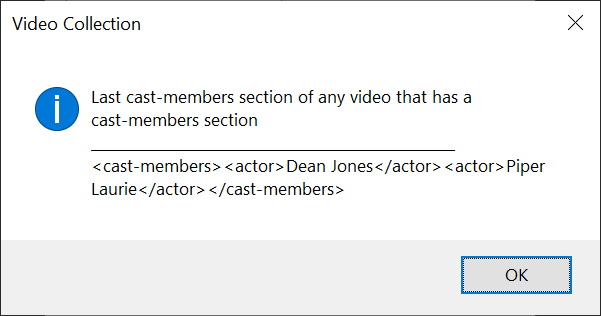Introduction to Functions
Introduction to Functions
Introduction
The XPath language provides many functions. Some functions are made to perform some of the operations we have applied already. Some other functions are meant to produce some results we have not gotten so far.
![]() Practical Learning: Introducing XPath Functions
Practical Learning: Introducing XPath Functions
The Position of a Node
We have seen that we can use the square brackets to get to the position of a node. The XPath language has a function named position that can be used to access a node based on its position. To use it, in the square brackets of the node that is considered the parent, assign the desired position to position().
As you may know already, the first child of a node has an index of 1. Therefore, to get the first child node, assign 1 to the position() function. Here is an example:
using System.Xml;
namespace VideoCollection1
{
public partial class Exercise : Form
{
public Exercise()
{
InitializeComponent();
}
private void btnVideos_Click(object sender, EventArgs e)
{
XmlDocument xdVideos = new XmlDocument();
xdVideos.Load("../../../Videos.xml");
XmlElement xeVideo = xdVideos.DocumentElement!;
XmlNodeList xnlVideos = xeVideo.SelectNodes("/videos/video[position() = 1]")!;
foreach(XmlNode xnVideo in xnlVideos)
{
MessageBox.Show(xnVideo.OuterXml,
"Video Collection: First Video",
MessageBoxButtons.OK, MessageBoxIcon.Information);
}
}
}
}
This would produce:

In the same way, to get to any node, assign its index to position().
The Last Child Node
To help you get to the last child node of a node, XPath proposes a function named last. Therefore, to get the last child node, pass last() as the index of the node that acts as the parent. Here is an example:
using System.Xml;
namespace VideoCollection1
{
public partial class Exercise : Form
{
public Exercise()
{
InitializeComponent();
}
private void btnVideos_Click(object sender, EventArgs e)
{
XmlDocument xdVideos = new XmlDocument();
xdVideos.Load("../../../Videos.xml");
XmlElement xeVideo = xdVideos.DocumentElement!;
// This expression first gets the 2nd video.
// Then it gets the 3rd actor of that video
XmlNodeList xnlVideos = xeVideo.SelectNodes("/videos/video[last()]")!;
foreach(XmlNode xnVideo in xnlVideos)
{
MessageBox.Show(string.Format("Video: {0}",
xnVideo.OuterXml),
"Video Collection",
MessageBoxButtons.OK, MessageBoxIcon.Information);
}
}
}
}
This would produce:

As an alternative, you can assign last() to position(). Here is an example:
using System.Xml;
namespace VideoCollection1
{
public partial class Exercise : Form
{
public Exercise()
{
InitializeComponent();
}
private void btnVideos_Click(object sender, EventArgs e)
{
XmlDocument xdVideos = new XmlDocument();
xdVideos.Load("../../../Videos.xml");
XmlElement xeVideo = xdVideos.DocumentElement!;
XmlNodeList xnlVideos = xeVideo.SelectNodes("/videos/video[position() = last()]")!;
foreach(XmlNode xnVideo in xnlVideos)
{
MessageBox.Show(string.Format("Video: {0}",
xnVideo.OuterXml),
"Video Collection",
MessageBoxButtons.OK, MessageBoxIcon.Information);
}
}
}
}
Consider the following example:
using System.Xml;
namespace VideoCollection1
{
public partial class Exercise : Form
{
public Exercise()
{
InitializeComponent();
}
private void btnVideos_Click(object sender, EventArgs e)
{
XmlDocument xdVideos = new XmlDocument();
xdVideos.Load("../../../Videos.xml");
XmlElement xeVideo = xdVideos.DocumentElement!;
XmlNodeList xnlVideos = xeVideo.SelectNodes("/videos/video/cast-members[last()]")!;
foreach(XmlNode xnVideo in xnlVideos)
{
MessageBox.Show(string.Format("Last cast-members section of any video " +
"that has a cast-members section\n" +
"____________________________________________________\n{0}",
xnVideo.OuterXml),
"Video Collection",
MessageBoxButtons.OK, MessageBoxIcon.Information);
}
}
}
}
This would produce:




Notice that the result includes all nodes from a parent that has a cast-members section. If you want to get only the last node that has that section, include the whole path in parentheses excluding the square brackets and their index. Here is an example:
using System.Xml;
namespace VideoCollection1
{
public partial class Exercise : Form
{
public Exercise()
{
InitializeComponent();
}
private void btnVideos_Click(object sender, EventArgs e)
{
XmlDocument xdVideos = new XmlDocument();
xdVideos.Load("../../../Videos.xml");
XmlElement xeVideo = xdVideos.DocumentElement!;
XmlNodeList xnlVideos = xeVideo.SelectNodes("(/videos/video/cast-members)[last()]")!;
foreach(XmlNode xnVideo in xnlVideos)
{
MessageBox.Show(string.Format("Last cast-members section\n" +
"____________________________________________________\n{0}",
xnVideo.InnerXml),
"Video Collection",
MessageBoxButtons.OK, MessageBoxIcon.Information);
}
}
}
}
This would produce:

![]() Practical Learning: Ending the Lesson
Practical Learning: Ending the Lesson
|
|
|||
| Previous | Copyright © 2014-2024, FunctionX | Tuesday 25 June 2024, 11:32 | Next |
|
|
|||